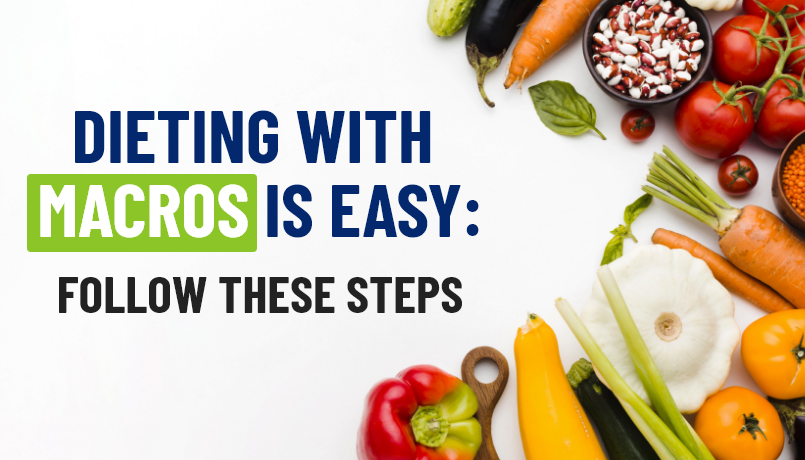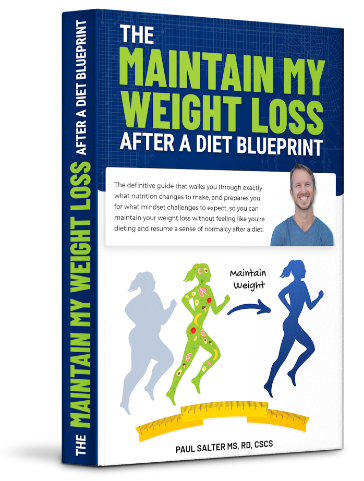Dieting with Macros is Easy: Follow these Steps

What’s A Macro?
The three major nutrients – protein, carbohydrates, and dietary fat – are collectively known as macronutrients.
“Macro-” meaning large, these nutrients are measured in grams whereas their smaller counterparts, micronutrients, are measured in milligrams and micrograms. Micronutrients refer to the vitamins and minerals found within foods we consume.
When someone talks about dieting with macros, what they’re referring to is having an individual goal number of grams of protein, carbohydrates, and fats to consume each day via their food choices. This is a more specific and slightly more detailed approach compared to counting calories.
Instead of counting calories (and a singular total calorie goal), you’re measuring macros (paying attention to three numbers).
The Role and Benefit of Each Macro
Dieting with macros compared to counting calories offers several unique advantages. But before we discuss those, it’s important to understand the role and key benefits of each individual macro.
There are several key differences between each of the three major nutrients, specifically, how they behave in the body, how the body responds to us eating more or less of each, and, of course, the function and benefits each provides.
For starters, each macro provides a slightly different number of calories (energy) per gram. A gram of both protein and carbohydrate provides four calories per gram whereas a gram of dietary fat provides nine calories.
The primary role of each nutrient is as follows:
- Protein: muscle growth, recovery, and repair; immune system support
- Carbohydrates: a primary and preferred energy source (specifically for the heart, muscles, brain, and nervous system)
- Dietary Fat: plays a critical role in hormone production and functioning, as well as serves as a secondary fuel source
Furthermore, each has a different impact on both energy levels and appetite.
- Protein: a last-resort energy source
- Carbohydrates: we rely on carbohydrates more for fuel as our exercise intensity increases*
- Dietary Fat: a primary fuel source specifically used at rest and lower intensity exercise
*We’re never relying 100 percent on a single nutrient for fuel. Each is used in various amounts depending on our exercise intensity.
Additionally, each macro has a unique impact on our appetite. Protein slows digestion and promotes satiety. High-fiber carbohydrates and dietary fat both slow digestion and promote satiety, too.
The Benefits of Dieting with Macros Versus Calories
When you only target a single calorie goal for the day, you leave too much flexibility and not enough structure between how to distribute those calories between the three macros.
For example, one day you may find that your calorie distribution is as follows:
- Protein: 22%
- Carbohydrates: 61%
- Fat: 17%
And another day could lead to:
- Protein: 34%
- Carbohydrates: 40%
- Fat: 26%
This inconsistency and loosey-goosey approach may lead to irregular and inconsistent eating habits, appetite, energy, and exercise recovery.
When it comes to achieving sustainable weight loss founded upon a sustainable nutrition plan, the structure is key.
Dieting with macros creates an opportunity to better take control of, and more positively influence, your appetite, energy, and exercise recovery; therefore, you’re better able to promote overall adherence to your nutrition plan.
Adherence is the most important factor to prioritize when focusing on your nutrition plan.
Read that again.
Adherence promotes consistency, and consistency is what fuels significant sustainable progress. If you’d like to learn exactly how to build your own sustainable nutrition plan that is rooted in individualization, simplicity, and flexibility – the three-ingredient recipe to promote adherence – click here to grab our training video and resource bundle!
Dieting With Macros – Does it Fit?
Dieting with macros – also more commonly known as taking an “if it fits your macros” (IIFYM) approach – is a flexible approach to managing your calorie goal and portion intake.
This approach promotes the inclusion of all foods – nutrient-dense and not-so-nutrient-dense options – so that you can have your cake and still hit your daily macro goals.
However, the one downside to this approach is it can quickly become quite complex…
For instance, following an IIFYM approach entails that you count the grams of protein, carbohydrates, and dietary fat in every single food you eat.
What I mean by that is if you’d like to enjoy a meal of salmon, couscous, and steamed broccoli, topped with a drizzle of olive oil, you’d count the protein, carbohydrates, and dietary fat in each of those foods, which means you’d need to account for a total of 12 variables in a single meal!
If you eat four times per day, that means you need to manage 48 nutrients when all is said and done.
Yuck!
Fortunately, there’s a simpler, far more effective way to dieting with macros that has served as the foundation of every individualized nutrition blueprint I’ve created for clients and customers alike in the past decade…
How to Count Macros – A Better Way
Rather than counting every single gram of protein, carbohydrates, and fat in every single bite of food we eat (redundant, right!?), what we teach at The 5% Way is a simplified approach that involves less counting and more living.
Below, you’ll find a step-by-step process that outlines the subtle mindset shifts and behaviors changes to simplify portion control via managing macros.
Determining Your Non-Negotiable Protein Goal:
- Determine the amount of protein you need per day in grams and then convert this number to ounces per day.
- Divide the number of ounces per day by the number of times you’d like to eat to find your individual goal ounces (and grams) per meal.
- Make the mindset shift that hitting this number each time you eat – whether a meal or snack – is non-negotiable. This will ingrain the number and eventually make it automatic, therefore, freeing up mental energy.
Only Count the Primary Nutrient in Carbohydrates and Dietary Fat:
- Only count the primary nutrient in protein, carbohydrate, and dietary fats. For instance, oats are a premium carbohydrate. Even though they do provide trace amounts of protein and carbohydrates, we only focus on the primary nutrient, which is carbohydrates in this case, to reduce the amount we count and manage.
- Repeat for fat, too.
- This creates a situation in which you’re only managing two nutrients per meal – carbohydrates and dietary fat.
- If you eat four meals per day, that’s a total of eight numbers per day, which is a heck of a lot easier to mentally digest compared to the 48 numbers via an IIFYM approach.
If you’d like our entire video training and course bundle that details this method and teaches you how to build a sustainable nutrition plan so that you can effortlessly eat with confidence to feel, look, and be your best, click here to snag this now!
End Your Marriage to MyFitnessPal
Dieting with macros is a fantastic framework to begin making more nutritious food choices without excluding those foods you love. However, the traditional approach is quite complex and can leave you feeling overwhelmed by the amount of logging, math, and macro puzzling you must complete each day to hit your goals. What I’ve outlined above is a simplified approach to dieting with macros that have been used to help thousands of women collectively lose thousands of pounds of body fat and keep it off for good.
If you want a more detailed overview of how to implement this approach yourself, I cannot recommend our course bundle that teaches you how to build your own sustainable nutrition plan so that you can effortlessly eat with confidence to feel, look, and be your best enough. Click here to begin watching.
If you need support during the pre-diet maintenance phase or rebuilding your relationship with food, click here to join The 5% Community and join women just like you who are working to feel, look, and be their best!
Share this post
 Paul Salter
Paul Salter
